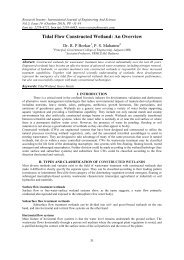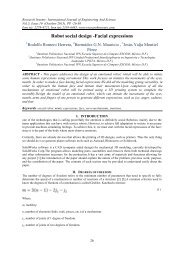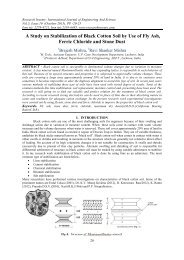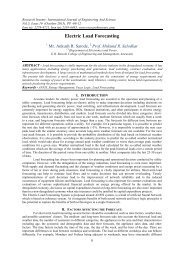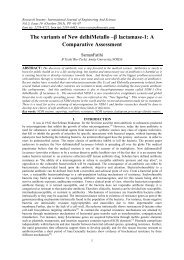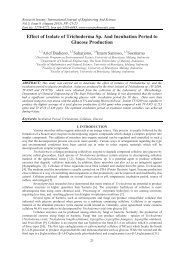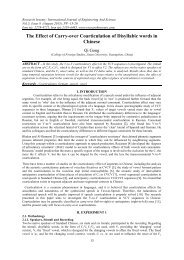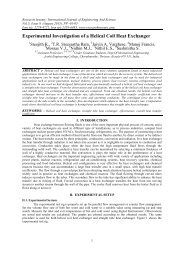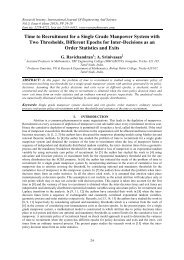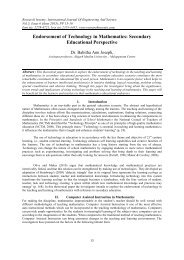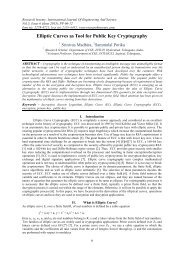Design of CPW-fed Capacitive Coupled Patch Antenna for WiGig Applications
You also want an ePaper? Increase the reach of your titles
YUMPU automatically turns print PDFs into web optimized ePapers that Google loves.
Research Inventy: International Journal Of Engineering And Science<br />
Vol.5, Issue 6 (June 2015), PP 17-23<br />
Issn (e): 2278-4721, Issn (p):2319-6483, www.researchinventy.com<br />
<strong>Design</strong> <strong>of</strong> <strong>CPW</strong>-<strong>fed</strong> <strong>Capacitive</strong> <strong>Coupled</strong> <strong>Patch</strong> <strong>Antenna</strong> <strong>for</strong> <strong>WiGig</strong><br />
<strong>Applications</strong><br />
K. J. Silva Lorraine 1 , Pavana sai.R 2 , Suresh babu.T 3 , Rama krishna.K 4 ,<br />
Tejaventh hari.T 5<br />
1 Assistant Pr<strong>of</strong>essor, Department <strong>of</strong> Electronics and Communication Engineering., Sir C R Reddy College <strong>of</strong><br />
Engineering.<br />
2,3,4,5 Department <strong>of</strong> Electronics and Communication Engineering.., Sir C R Reddy College <strong>of</strong> Engineering.<br />
Eluru - 534 007, AP, INDIA.<br />
ABSTRACT— The area <strong>of</strong> microstrip antennas has seen some inventive work in recent years and is one <strong>of</strong> the<br />
most dynamic fields <strong>of</strong> antenna theory. The ever increasing need <strong>for</strong> mobile communication and the emergence<br />
<strong>of</strong> newer technologies require an efficient design <strong>of</strong> antenna <strong>of</strong> smaller size <strong>for</strong> wider frequency range<br />
applications such as <strong>WiGig</strong>. The design, simulation, and characterization <strong>of</strong> a <strong>CPW</strong>-<strong>fed</strong> microstrip antenna<br />
capable <strong>of</strong> covering the entire IEEE 802.11ad (<strong>WiGig</strong>) frequency band (57–66 GHz) has been presented in this<br />
paper. A conductor-backed (CB) coplanar waveguide (<strong>CPW</strong>)-<strong>fed</strong> loop slot couples the energy to the patch<br />
antenna, resulting in a broad bandwidth. The substrate used here is quartz substrate ( r=3.9, tan δ=0.0002 at 60<br />
GHz), on top <strong>of</strong> which an SU-8-based three-dimensional (3-D) structure with air cavities has been placed. The<br />
patch metallization is deposited on top <strong>of</strong> this 3-D structure. Simulation <strong>of</strong> the proposed antenna has been<br />
carried out <strong>for</strong> different geometries and impedance tuning coupling mechanisms. Parametric study was included<br />
to determine the effect <strong>of</strong> design towards the antenna per<strong>for</strong>mance. The design was optimized to meet the best<br />
possible result. The proposed antenna has also found to be promising to be embedded with devices employing<br />
<strong>WiGig</strong> applications.<br />
Keywords— Coplanar waveguide (<strong>CPW</strong>), IEEE 802.11ad, SU-8, <strong>WiGig</strong>.<br />
I. INTRODUCTION<br />
Modern multimedia applications demand higher data rates, and the trend towards wireless is evident.<br />
To satisfy the industries requirement in order to get high data rates around 7 Gbit/s, <strong>WiGig</strong> is an option.<br />
Operating at 57-66 GHz bandwidth we can archive this bench mark as per the standard <strong>of</strong> IEEE 802.11ad [4].<br />
But, bandwidth demands are still rising. In such a context, 60 GHz millimeter wave (MMW) systems constitute<br />
a very attractive solution, due to the fact that there is a several GHz unlicensed frequency range available around<br />
60 GHz,[6] almost worldwide. In Europe the frequency ranges 62-63 GHz and 65-66 GHz are reserved <strong>for</strong><br />
wideband mobile networks MBS, (Mobile Broadband System), whereas 59-62 GHz range is reserved <strong>for</strong><br />
wideband wireless local area networks (WLAN). In USA and South Korea, the frequency range 57-64 GHz is<br />
generally an unlicensed range. In Japan, 59-66 GHz is reserved <strong>for</strong> wireless communications [4]. This massive<br />
spectral space enables densely situated, non-interfering wireless networks to be used in the most bandwidthstarving<br />
applications <strong>of</strong> the future, in all kinds <strong>of</strong> short-range (< 1 km) wireless communication.<br />
The Wireless Gigabit Alliance (<strong>WiGig</strong>) was a trade association that developed and promoted the<br />
adoption <strong>of</strong> multi-gigabit speed wireless communications technology operating over the unlicensed 60 GHz<br />
frequency band. The <strong>WiGig</strong> specification allows devices to communicate without wires at multi-gigabit speeds.<br />
<strong>WiGig</strong> enabled devices, deliver data transfer rates up to 7 Gbit/s, about as fast as an 8<br />
antenna 802.11ac transmission, and nearly 50 times faster than the highest 802.11n rate, while maintaining<br />
compatibility with existing Wi-Fi devices. The Wireless Gigabit Alliance was <strong>for</strong>med to provide a single multigigabit<br />
wireless communications standard among consumer electronics like display and audio applications,<br />
handheld devices and PCs, and drives industry convergence using unlicensed ISM (industrial, scientific and<br />
medical) 60 GHz spectrum.<br />
17
<strong>Design</strong> <strong>of</strong> <strong>CPW</strong>-<strong>fed</strong> <strong>Capacitive</strong> <strong>Coupled</strong> <strong>Patch</strong> <strong>Antenna</strong> <strong>for</strong> <strong>WiGig</strong> <strong>Applications</strong><br />
II. ANTENNA DESIGN<br />
The main aim behind this antenna design is to implement with low cost and good impedance matching<br />
at millimetre wave lengths. It’s a task to design antenna at mm wave frequencies because <strong>of</strong> its smaller<br />
dimensions. The role behind the <strong>CPW</strong>- <strong>fed</strong> is to have low radiation loss, less dispersion, easy integration <strong>for</strong><br />
monolithic microwave circuits (MMICs) and a simple configuration with single metallic layer, since no<br />
backside processing is required <strong>for</strong> integration <strong>of</strong> devices [2]. There<strong>for</strong>e, the designs <strong>of</strong> <strong>CPW</strong>-<strong>fed</strong> antennas have<br />
recently become more and more attractive. One <strong>of</strong> the main issues with <strong>CPW</strong>-<strong>fed</strong> antennas is to provide an easy<br />
impedance matching to the <strong>CPW</strong>-<strong>fed</strong> line. In order to obtain multiband and broadband operations, several<br />
techniques have been reported in the literatures based on <strong>CPW</strong>-<strong>fed</strong> slot antennas [3].<br />
<strong>Design</strong> specifications<br />
The substrate used here is quartz ( r=3.9, tan δ=0.0002 at 60 GHz). For enhanced band width, quartz is used<br />
as a substrate. On top <strong>of</strong> that su-8 structure with air cavities are designed. In order to create thick enough<br />
substrates, SU-8 ( r=3.1, tan δ =0.021 ) [7], is an excellent choice [1]. However, its high loss tangent is the drawback<br />
<strong>for</strong> using it as a dielectric <strong>for</strong> planar antennas. Techniques such as creating holes, air cavities, etc., reduce the<br />
effect <strong>of</strong> dielectric loss on the antenna per<strong>for</strong>mance [8]. Combining the advantages <strong>of</strong> SU-8 along with these<br />
techniques yields an antenna substrate that is both electrically and mechanically an efficient solution. Hence, in<br />
this paper, micro fabricated SU-8-based three-dimensional (3-D) structures with air cavities are used as low-loss<br />
alternative substrates <strong>for</strong> <strong>WiGig</strong> antennas. Table I shows the design parameters <strong>of</strong> <strong>CPW</strong>-<strong>fed</strong> capacitive coupled<br />
patch antenna.<br />
TABLE I. DESIGN PARAMETERS<br />
Parameters<br />
Center rectangular dimensions<br />
Center feed line dimensions<br />
Substrate<br />
Bottom cu ground<br />
Top cu ground<br />
Su-8 structure posts<br />
Su-8 top dimensions<br />
Dimensions<br />
0.8mm x 2mm<br />
3.5mm x 0.191mm<br />
7mm x 7mm x 525um<br />
7mm x 7mm x 0.03mm<br />
7mm x 7mm x 0.03mm<br />
600um x 750um x 0.2mm<br />
2.6mm x 7mm x 0.1mm<br />
III. RESULTS AND DISCUSSIONS<br />
In this section, the per<strong>for</strong>mance <strong>of</strong> the proposed antenna is demonstrated through its simulated results.<br />
The simulated results in term <strong>of</strong> return loss, radiation pattern has been exhibited and illustrated.<br />
The antenna as depicted in Fig. 1(a) is a <strong>CPW</strong>-<strong>fed</strong> broadband patch antenna on an RF-compatible<br />
quartz substrate. The feed metallization, which consists <strong>of</strong> a CB <strong>CPW</strong>, along with the loop is <strong>for</strong>med on a 525-<br />
μm thick quartz substrate. The 3-D substrate consists <strong>of</strong> an SU-8 membrane that is supported via SU-8 posts.<br />
The patch antenna metallization is finally <strong>for</strong>med on this 3-D substrate.<br />
The location <strong>of</strong> SU-8 posts and the thickness <strong>of</strong> SU-8 photo resist membrane dictate the mechanical<br />
stability <strong>of</strong> the 3-D antenna. As SU-8 is quite lossy, an intelligent design trade<strong>of</strong>f between the mechanical<br />
integrity <strong>of</strong> the 3-D structure and the per<strong>for</strong>mance <strong>of</strong> the antenna needs to be incorporated. Accordingly, air<br />
cavities are incorporated in the 3-D SU-8 substrate to reduce the dielectric loss, which would in turn enhance the<br />
per<strong>for</strong>mance <strong>of</strong> the antenna. The height <strong>of</strong> the air cavity, which is also the height <strong>of</strong> SU-8 posts, has an effect on<br />
the impedance BW and realized gain <strong>of</strong> the antenna [1].<br />
Fig. 1(a) Simulation model <strong>of</strong> <strong>CPW</strong> <strong>fed</strong> Rectangular <strong>Patch</strong> <strong>Antenna</strong><br />
18
<strong>Design</strong> <strong>of</strong> <strong>CPW</strong>-<strong>fed</strong> <strong>Capacitive</strong> <strong>Coupled</strong> <strong>Patch</strong> <strong>Antenna</strong> <strong>for</strong> <strong>WiGig</strong> <strong>Applications</strong><br />
Fig. 1(b) Return loss plot <strong>of</strong> <strong>CPW</strong> <strong>fed</strong> Rectangular <strong>Patch</strong> <strong>Antenna</strong><br />
Fig 1(c) Gain radiation pattern <strong>of</strong> <strong>CPW</strong> <strong>fed</strong> Rectangular <strong>Patch</strong> <strong>Antenna</strong><br />
Fig. 1(a) shows the simulation model <strong>of</strong> rectangular shape <strong>CPW</strong> <strong>fed</strong> microstrip antenna <strong>for</strong> <strong>WiGig</strong> applications.<br />
Fig 1(b) shows the return loss plot and Fig 1(c) shows the gain plot <strong>for</strong> <strong>CPW</strong> <strong>fed</strong> Rectangular patch antenna.<br />
From Fig 1(b), it can be observed that the resonant frequency <strong>of</strong> the patch is 61.41GHz and the value <strong>of</strong> return<br />
loss at the resonant frequency is -22.03dB. Also, the bandwidth <strong>of</strong> the patch is approximately 10 GHz, at -10dB<br />
points [10].<br />
Fig. 2(a) Simulation model <strong>of</strong> <strong>CPW</strong>-<strong>fed</strong> Circular <strong>Patch</strong> <strong>Antenna</strong><br />
19
<strong>Design</strong> <strong>of</strong> <strong>CPW</strong>-<strong>fed</strong> <strong>Capacitive</strong> <strong>Coupled</strong> <strong>Patch</strong> <strong>Antenna</strong> <strong>for</strong> <strong>WiGig</strong> <strong>Applications</strong><br />
Fig. 2(b) Return loss plot <strong>of</strong> <strong>CPW</strong>-<strong>fed</strong> Circular <strong>Patch</strong> <strong>Antenna</strong><br />
Fig. 2(c) Gain radiation pattern <strong>of</strong> <strong>CPW</strong> <strong>fed</strong> Circular <strong>Patch</strong> <strong>Antenna</strong><br />
Fig. 2(a) shows the simulation model <strong>of</strong> Circular shape <strong>CPW</strong> <strong>fed</strong> microstrip antenna <strong>for</strong> <strong>WiGig</strong> applications. Fig<br />
2(b) shows the return loss plot. From the Fig 2(b), it can be observed that the stimulated antenna resonates at<br />
63.41GHz with return loss <strong>of</strong> -33.3 dB and bandwidth <strong>of</strong> the patch antenna at -10dB points is approximately 7.8<br />
GHz. Also, the resonant frequency <strong>for</strong> <strong>CPW</strong>-<strong>fed</strong> circular antenna shows an upward shift. Fig 2(c) shows the<br />
gain plot <strong>for</strong> <strong>CPW</strong> <strong>fed</strong> Rectangular patch antenna. From the radiation pattern it can be observed that circular<br />
<strong>CPW</strong> <strong>fed</strong> circular patch antenna has found to be more directional than rectangular shape <strong>CPW</strong>-<strong>fed</strong> antenna [10].<br />
TABLE III<br />
COMPARISON OF <strong>CPW</strong>-FED PATCH ANTENNA WITH VARIOUS GEOMETRIES<br />
<strong>Antenna</strong><br />
type<br />
Rectangula<br />
r shape<br />
Circular<br />
shape<br />
Return<br />
loss<br />
(S 11 )<br />
-<br />
18.20dB<br />
-<br />
34.16d<br />
B<br />
Peak<br />
gain<br />
Peak<br />
Directivit<br />
y<br />
Front<br />
to Back<br />
Ratio<br />
4.514 4.356 74.62<br />
5.663 5.516 79.15<br />
Table II gives the comparative analysis <strong>of</strong> <strong>CPW</strong> <strong>fed</strong> rectangular patch antenna and circular patch antenna in<br />
terms <strong>of</strong> various antenna parameters such as return loss, peak gain, directivity and front to back ratio. It can be<br />
observed that circular <strong>CPW</strong> <strong>fed</strong> Circular patch antenna has found to be more superior than rectangular shape<br />
<strong>CPW</strong>-<strong>fed</strong> antenna interms <strong>of</strong> all the parameters.<br />
One <strong>of</strong> the main issues with <strong>CPW</strong>-<strong>fed</strong> slot antennas is to provide an easy impedance matching to the<br />
<strong>CPW</strong> line [8]. So far, several impedance tuning techniques based on a change <strong>of</strong> slot dimensions, coupling<br />
mechanism or both have been reported in the literatures [9]. Hence, the design <strong>of</strong> <strong>CPW</strong>-<strong>fed</strong> patch antenna with<br />
various coupling mechanisms has also been simulated and presented.<br />
20
<strong>Design</strong> <strong>of</strong> <strong>CPW</strong>-<strong>fed</strong> <strong>Capacitive</strong> <strong>Coupled</strong> <strong>Patch</strong> <strong>Antenna</strong> <strong>for</strong> <strong>WiGig</strong> <strong>Applications</strong><br />
Fig. 3(a) Simulation model <strong>of</strong> <strong>CPW</strong>-<strong>fed</strong> patch antenna with Inductive coupling<br />
Fig. 3(b) Return loss plot <strong>of</strong> <strong>CPW</strong>-<strong>fed</strong> patch antenna with Inductive coupling<br />
Fig. 3(c) Gain radiation pattern <strong>of</strong> <strong>CPW</strong>-<strong>fed</strong> patch antenna with Inductive coupling<br />
Fig. 4(a) Simulation model <strong>of</strong> <strong>CPW</strong>-<strong>fed</strong> patch antenna with capacitive coupling<br />
21
<strong>Design</strong> <strong>of</strong> <strong>CPW</strong>-<strong>fed</strong> <strong>Capacitive</strong> <strong>Coupled</strong> <strong>Patch</strong> <strong>Antenna</strong> <strong>for</strong> <strong>WiGig</strong> <strong>Applications</strong><br />
Fig. 4(b) Return loss plot <strong>of</strong> <strong>CPW</strong>-<strong>fed</strong> patch antenna with capacitive coupling<br />
Fig. 3(a) shows the simulation model <strong>of</strong> inductive coupled <strong>CPW</strong> <strong>fed</strong> microstrip antenna <strong>for</strong> <strong>WiGig</strong><br />
applications and Fig 3(b) shows the return loss plot. It can be observed that the resonant frequency <strong>of</strong> the patch<br />
is 83GHz and the value <strong>of</strong> return loss at the resonant frequency is -40.03dB. Fig. 4(a) shows the simulation<br />
model <strong>of</strong> capacitive coupled <strong>CPW</strong> <strong>fed</strong> microstrip antenna <strong>for</strong> <strong>WiGig</strong> applications. From Fig. 4(b), it can be<br />
observed that the patch antenna resonates at 60GHz with a return loss <strong>of</strong> -50.03dB. . Also, the resonant<br />
frequency <strong>for</strong> <strong>CPW</strong> <strong>fed</strong> antenna shows an upward shift. Fig. 3(c) and 4(c) it can be seen that capacitive coupled<br />
antenna has high directivity than inductive coupled antenna.<br />
Fig. 4(c) Gain radiation pattern <strong>of</strong> <strong>CPW</strong>-<strong>fed</strong> patch antenna with capacitive coupling<br />
TABLE IIIII<br />
COMPARISON OF <strong>CPW</strong>-FED PATCH ANTENNA WITH VARIOUS COUPLING MECHANISMS<br />
<strong>Antenna</strong><br />
type<br />
<strong>Capacitive</strong><br />
coupling<br />
Inductive<br />
coupling<br />
Return<br />
loss (S 11 )<br />
Peak<br />
gain<br />
Peak<br />
directivity<br />
Front to<br />
Back<br />
Ratio<br />
-49.68 dB 2.143 2.039 50.761<br />
-24.68 dB 0.937 0.88 2.191<br />
Table III gives the comparative analysis <strong>of</strong> <strong>CPW</strong> <strong>fed</strong> capacitive coupling antenna and inductive<br />
coupling antenna in terms <strong>of</strong> various antenna parameters such as return loss, peak gain, directivity and front to<br />
back ratio. It can be observed that capacitive <strong>CPW</strong> <strong>fed</strong> patch antenna has found to be more superior than<br />
inductive coupling <strong>CPW</strong>-<strong>fed</strong> antenna interms <strong>of</strong> all the parameters. Hence, it can be concluded that capacitive<br />
coupled is suitable <strong>for</strong> <strong>WiGig</strong> applications. However, inductive coupling is suitable <strong>for</strong> next generation high<br />
speed wireless communication operating at 120GHz.<br />
22
<strong>Design</strong> <strong>of</strong> <strong>CPW</strong>-<strong>fed</strong> <strong>Capacitive</strong> <strong>Coupled</strong> <strong>Patch</strong> <strong>Antenna</strong> <strong>for</strong> <strong>WiGig</strong> <strong>Applications</strong><br />
IV. CONCLUSION<br />
Wireless communications have progressed very rapidly in recent year and many mobile units are<br />
becoming smaller and smaller. To meet the miniaturization requirement, the antennas employed in mobile<br />
terminals must have their dimensions reduced accordingly. Planar antennas, such as microstrip and printed<br />
antennas, have the attractive features <strong>of</strong> low pr<strong>of</strong>ile, small size, and con<strong>for</strong>mability to mounting hosts.<br />
In this paper, a <strong>CPW</strong>-<strong>fed</strong> broadband patch antenna compatible with IEEE 802.11ad standard (<strong>WiGig</strong>)<br />
has been designed, and characterized. Extensive simulations have been carried <strong>for</strong> various shapes and<br />
impedance matching coupling mechanisms to study the per<strong>for</strong>mance <strong>of</strong> antenna. Analysing the results, it has<br />
been observed that, in terms <strong>of</strong> geometry circular is more effective and capacitive coupling in terms <strong>of</strong><br />
impedance matching coupling mechanisms. Hence, it can be concluded that <strong>CPW</strong>-<strong>fed</strong> capacitive coupled<br />
circular patch antenna is most promising to be embedded in devices employing <strong>WiGig</strong> applications as it<br />
provides a lesser return loss <strong>of</strong> -49.68dB and optimum directivity value <strong>of</strong> 2.039.<br />
REFERENCES<br />
[1] H. Mopidevi, H. V. Hunerli et al, ‖Three-Dimensional Micr<strong>of</strong>abricated Broadband <strong>Patch</strong> <strong>Antenna</strong> <strong>for</strong> <strong>WiGig</strong> <strong>Applications</strong>‖ IEEE<br />
ANTENNAS AND WIRELESS PROPAGATION LETTERS, VOL. 13, 2014<br />
[2] <strong>CPW</strong>-<strong>fed</strong> slot antennas(Chaimool et al., 2004, 2005, 2008; Sari-Kha et al., 2006; Jirasakulporn, Advanced Transmission Techniques<br />
in WiMAX2008),<br />
[3] <strong>CPW</strong>-<strong>fed</strong> printed monopole (Chaimool et al., 2009; Moekham et al., 2011) and fractal techniques (Mahatthanajatuphat et al., 2009;<br />
Honghara et al., 2011).<br />
[4] Wireless LAN Medium Access Control (MAC) and Physical Layer (PHY) Specification, IEEE Std. 802.11, 1997.<br />
[5] Richardson, A. J. and P. A.Watson, Use <strong>of</strong> the 55-65 GHz oxygen absorption band <strong>for</strong>t short-range broadband radio networks with<br />
minimal regulatory control," Proc. Inst. Elect. Eng, Vol. 137, 233-241,Aug.1990.<br />
[6] Smulders, P. F. M., \60 GHz radio: Prospects and future directions," Proceedings Symposium IEEE Benelux Chapter on<br />
Communications and Vehicular Technology,1-8,Eindhoven,2003.<br />
[7] A.-D. Campo and C. Greiner, ―SU-8: a photoresist <strong>for</strong> high-aspect-ratio and 3D submicron lithography,‖ J. Micromech. Micro eng.,<br />
vol. 17, pp. R81–R95, 2007.<br />
[8] D. R. Jackson, J. T. Williams, and A. K. Bhattacharyya, ―Microstrip patch designs that do not excite surface waves,‖ IEEE Trans.<br />
<strong>Antenna</strong>s Propag., vol. 41, no. 8, pp. 1026–1037, Aug. 1993.<br />
[9] Kung Bo Ng and Chi Hou Chan ―A Differentially-Fed Complementary <strong>Antenna</strong> <strong>for</strong> <strong>WiGig</strong> <strong>Applications</strong>‖<br />
[10] <strong>Antenna</strong> basics, McGraw-Hill Higher Education [Online] Available:<br />
http://higherd.mcgrawhill.com/sites/dl/free/0072321032/62577/ch02_011_056.pdf<br />
[11] Vasishath Kaushal, Tanvir Singh,Vinay Kumar,Amit Kumar, Dr. Dilip Kumar, ―A Comprehensive Study <strong>of</strong> <strong>Antenna</strong> Terminology<br />
Using HFSS,‖ IJECT Vol. 5, Issue spl-1, Jan - March 2014.<br />
[12] HFSS Ans<strong>of</strong>t – Ans<strong>of</strong>t Corporation, Help, Canonsburg, Version 13, PA, 2011.<br />
23



